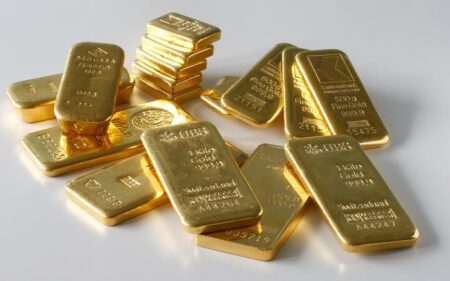Investing.com– Gold prices fell on Monday, reversing course after increased safe haven demand spurred a series of strong gains in the yellow metal, with focus remaining on any potential spillover from the Israel-Hamas war.
The yellow metal saw a touch of profit taking after jumping over 5% in the prior week, as the onset of the Israel-Hamas war sent investors dashing for safe haven assets.
Markets were now watching to see whether the Israel-Hamas conflict would spill over into the Middle East region, as Israel prepares a ground offensive in the Gaza strip.
Gold’s most-active contract on New York’s Comex, December, settled down $7.20, or 0.4%, at $1,934.30 an ounce.
The , more closely watched by some traders than futures, was at $1,919.46.65 by 15:50 ET (19:50 GMT), down $13.36, or 0.7%, on the day.
-Higher U.S. rate outlook limits gold’s appeal
Stronger-than-expected U.S. released last week pointed to a sustained hawkish stance from the Federal Reserve, which is likely to keep interest rates higher for longer.
This notion had battered gold prices over the past year, and with U.S. rates set to remain stubbornly high, is likely to limit any major upside in the yellow metal.
While gold did see some strong gains on safe haven demand, the dollar still largely remained the safe haven of choice. Inflows to the saw it come close to a 10-month peak last week.
Higher interest rates bode poorly for gold, given that they push up the opportunity cost of investing in the yellow metal. This notion had limited any major gains in the yellow metal, even as worsening global economic conditions made for increased safe haven demand.
Copper rebounds with China GDP in focus
Among industrial metals, copper prices rose on Monday after coming close to a five-month low in the prior week.
settled up 0.1% at $3.5820 a pound in New York trading.
Focus this week is squarely on key economic readings from major copper importer China, mainly a reading on third-quarter .
The reading is expected to show that Chinese economic growth weakened further in the prior quarter as business activity showed little signs of improvement despite some stimulus measures.
Such a trend bodes poorly for Chinese copper demand, and could spark more weakness in the red metal in the coming weeks. Concerns over China have been a key dampener on copper prices over the past year.
The People’s Bank of China is also expected to decide on its key this week, although a change appears unlikely.
(Barani Krishnan contributed to this report)
Read the full article here












